- Home
- About
- Map
- Trips
- Bringing Boat West
- Migration West
- Solo Motorcycle Ride
- Final Family XC Trip
- Colorado Rockies
- Graduates' XC Trip
- Yosemite & Nevada
- Colorado & Utah
- Best of Utah
- Southern Loop
- Pacific Northwest
- Northern Loop
- Los Angeles to NYC
- East Coast Trips
- 1 Week in Quebec
- Southeast Coast
- NH Backpacking
- Martha's Vineyard
- Canadian Maritimes
- Ocracoke Island
- Edisto Island
- First Landing '02
- Hunting Island '02
- Stowe in Winter
- Hunting Island '01
- Lake Placid
- Chesapeake
- Provincetown
- Hunting Island '00
- Acadia in Winter
- Boston Suburbs
- Niagara Falls
- First Landing '99
- Cape Hatteras
- West Coast Trips
- Utah Off-Roading
- Maui
- Mojave 4WD Course
- Colorado River Rafting
- Bishop & Death Valley
- Kauai
- Yosemite Fall
- Utah Off-Road
- Lost Coast
- Yosemite Valley
- Arizona and New Mexico
- Pescadero & Capitola
- Bishop & Death Valley
- San Diego, Anza Borrego, Joshua Tree
- Carmel
- Death Valley in Fall
- Yosemite in the Fall
- Pacific Northwest
- Utah Off-Roading
- Southern CA Deserts
- Yosemite & Covid
- Lake Powell Covid
- Eastern Sierra & Covid
- Bishop & Death Valley
- Central & SE Oregon
- Mojave Road
- Eastern Sierra
- Trinity Alps
- Tuolumne Meadows
- Lake Powell Boating
- Eastern Sierra
- Yosemite Winter
- Hawaii
- 4WD Eastern Sierra
- 4WD Death Valley +
- Southern CA Deserts
- Christmas in Tahoe
- Yosemite & Pinnacles
- Totality
- Yosemite & Sierra
- Yosemite Christmas
- Yosemite, San Diego
- Yosemite & North CA
- Seattle to Sierra
- Southwest Deserts
- Yosemite & Sierra
- Pacific Northwest
- Yosemite & South CA
- Pacific Northwest
- Northern California
- Southern Alaska
- Vancouver Island
- International Trips
- Index
- Tips
- Books
- Photos/Videos
- Search
- Contact
North Shore - The Cliffs at Princeville, HI
Sunday, January 14, 2024 - 2:00pm by Lolo
42 miles and 1.25 hours from our last stop - 4 night stay
Travelogue
Day 7 - Check out of the Sheraton and drive to the north shore north to stay at the Cliffs at Princeville
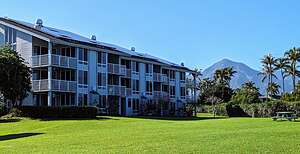 The Cliffs at PrincevilleIt had been a lovely stay at the Sheraton, but we had pretty much seen and done everything we had wanted, so we were excited to head to the northern shore of Kauai where we had more fun things planned.
The Cliffs at PrincevilleIt had been a lovely stay at the Sheraton, but we had pretty much seen and done everything we had wanted, so we were excited to head to the northern shore of Kauai where we had more fun things planned.
Against Herb’s wishes, we made a stop at Costco as we passed through Lihue to stock up on more breakfast and lunch items. This time rather than having to confine ourselves to a mini fridge, we had a full kitchen.
I had reserved a one-bedroom suite with an ocean view on Bookiong.com at the Cliffs at Princeville, a timeshare community perched on the edge of a cliff overlooking the Pacific, however, when we got there, there was a bit of confusion, and they sent us instead to a first-floor suite with a view of a hedge.
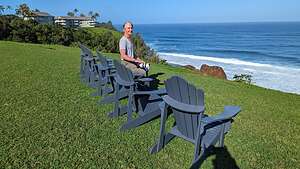 The Cliffs at PrincevilleThis just wouldn’t do, so we marched back to the Reception Area and informed them that there had been some kind of a mistake, as our reservation specifically said ocean view. After some apologetic mumbling and fiddling on the computers, they switched us to a second story suite in a building near the cliff with an ocean view. Herb was very proud of my feistiness in dealing with the reception clerk.
The Cliffs at PrincevilleThis just wouldn’t do, so we marched back to the Reception Area and informed them that there had been some kind of a mistake, as our reservation specifically said ocean view. After some apologetic mumbling and fiddling on the computers, they switched us to a second story suite in a building near the cliff with an ocean view. Herb was very proud of my feistiness in dealing with the reception clerk.
The suite was beautiful - full kitchen, dining area, living room, and bedroom, with a balcony off the living room with an ocean view and another balcony off the bedroom with a garden (and parking lot) view. We were very happy with our situation.
Once we were settled in, we took a bottle of wine and walked out to the cliff’s edge where there were about a dozen adirondack chairs to sit in and watch the sun set.
Beside the lovely view, there were two interesting birds wandering around: roosters and nene geese.
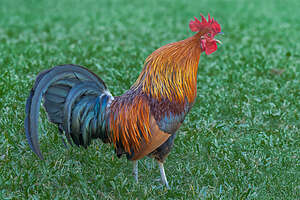 Feral RoosterFirst the rooster, which was outsmarting me in my attempt to photograph it. These birds are everywhere on the island, acting like they own the place - wandering through restaurants, crossing the streets (without looking both ways), and any expanse of grass they can find.
Feral RoosterFirst the rooster, which was outsmarting me in my attempt to photograph it. These birds are everywhere on the island, acting like they own the place - wandering through restaurants, crossing the streets (without looking both ways), and any expanse of grass they can find.
According to local lore, the reason there are so many roosters wandering around freely on the island is that two hurricanes (Iwa in 1982 and Iniki in 1992) destroyed domestic chicken coops, thereby setting them free. These domesticated birds then mated with the wild red junglefowl, resulting in the feral chickens that are everywhere today.
They are actually quite beautiful, especially when the sun shines on their colorful feathers.
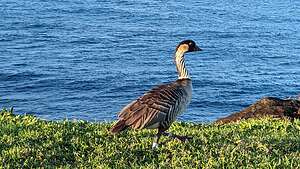 The endangered Nene GooseThe other bird that was joining us for sunset cocktail hours was the Nene, an endangered goose that looks similar to the Canadian Goose except for its coloring and its diagonal black and white stripes. These stripes are caused by diagonal rows of white feathers with black skin showing through.
The endangered Nene GooseThe other bird that was joining us for sunset cocktail hours was the Nene, an endangered goose that looks similar to the Canadian Goose except for its coloring and its diagonal black and white stripes. These stripes are caused by diagonal rows of white feathers with black skin showing through.
When Captain Cook arrived in the Hawaiian islands in1778, the nene was quite common. But hunting and predators like mongooses, pigs, dogs, and cats reduced the population to just 30 birds by 1952. Today, after much effort, they have been brought back from the brink of extinction and re-introduced into the wild. Today, there are 2,500 nenes in the wild, but it is still the 6th-most endangered waterfowl species in the world.
Then it was back to our lovely suite for a dinner of salad and sandwiches ala Costco.
Before going to bed, we decided to walk over to the lovely pool, right across the way from our building and take a soak in the hot tub. We asked the other couple that was already in the hot tub and they replied Santa Rosa, California, which just so happens to be where we are from. Small world.
Day 8 - Hanalei Bread Company, stroll on Hanalei Beach, and muddy hike from Ke’e Beach to Hanakapi’ai Beach
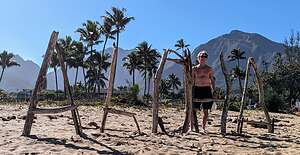 Hanalei BeachOne of the major things we wanted to do on the north shore was to hike a section of the Kalalau Trail in Hāʻena State Park, the most famous backpacking trail in all of Hawaii. This trail is the only way visitors can visit the Na Pali Coast via land, because there is no road.
Hanalei BeachOne of the major things we wanted to do on the north shore was to hike a section of the Kalalau Trail in Hāʻena State Park, the most famous backpacking trail in all of Hawaii. This trail is the only way visitors can visit the Na Pali Coast via land, because there is no road.
To do the whole trail requires a backpacking permit as it will take several days to complete the very strenuous 20-miles (out-and-back) along miles of switchbacks, precarious narrow trails, precarious drop-offs, and usually muddy conditions.
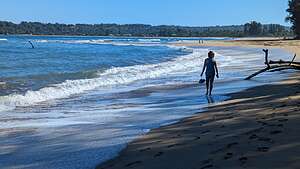 Stroll along Hanalei BayThe only part of the Kalalau Trail open for day visitors is the first 2 miles from Ke’e Beach, where we parked, to Hanakapi’ai Beach. From Hanakapi’ai Beach there is an additional 1.8 mile side trail upstream to Hanakapi’ai Falls, one of the more spectacular falls on the north shore.
Stroll along Hanalei BayThe only part of the Kalalau Trail open for day visitors is the first 2 miles from Ke’e Beach, where we parked, to Hanakapi’ai Beach. From Hanakapi’ai Beach there is an additional 1.8 mile side trail upstream to Hanakapi’ai Falls, one of the more spectacular falls on the north shore.
Because it has become so popular, you now need reservations to enter Hāʻena State Park and to access the Kalalau Trail. Anyone that wants to enter the park must make online reservations to either drive in and park or ride a shuttle.
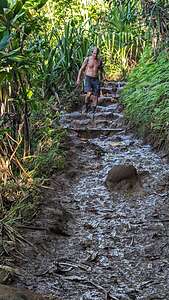 The muddy Kalalau trailThe parking spots, which we very much preferred, are extremely difficult to get and you must reserve one of three time slots: 6:30 am – 12:30 pm, 12:30 pm – 5:30 pm, or 4:30 pm – sunset.
The muddy Kalalau trailThe parking spots, which we very much preferred, are extremely difficult to get and you must reserve one of three time slots: 6:30 am – 12:30 pm, 12:30 pm – 5:30 pm, or 4:30 pm – sunset.
Before leaving for Hawaii, I was only to get a 4:30 pm slot, which wouldn’t allow much time for hiking. When we were in Hawaii, I kept looking at the website, and was eventually able to grab a cancellation for the 12:30 pm slot on the same day, which was great, because it would allow us to do the hike to Hanakapi’ai Beach.
We still had all morning, so we drove to the Hanalei, stopping first at the Hanalei Bread Company to pick up some sandwiches for our hike. It was an extremely popular place, so we had to wait quite a while on line. Then we drove over to take a stroll on lovely Hanalei Beach, which we had seen from above during our helicopter ride.
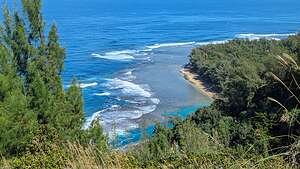 Ke'e Beach from the Kalalau trailIt was a very pretty beach, great for families because of the calmer waters of the bay.
Ke'e Beach from the Kalalau trailIt was a very pretty beach, great for families because of the calmer waters of the bay.
Herb became fascinated with photographing two coconuts bobbing in the surf, which I found quite amusing. We named one of his little coconut friends Wilson.
Further down the beach, we came to a large "ALOHA" structure made with tree branches that had washed ashore.
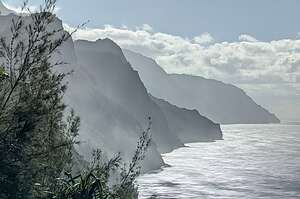 View of Napali CoastIt was almost time for our 12:30 parking reservation in Hāʻena State Park, so we drove the narrow road to the park, crossing several bridges, that often get flooded and impassable, to the end of the road. This is as far as you can drive on the north shore.
View of Napali CoastIt was almost time for our 12:30 parking reservation in Hāʻena State Park, so we drove the narrow road to the park, crossing several bridges, that often get flooded and impassable, to the end of the road. This is as far as you can drive on the north shore.
As I mentioned in my description of our drives through Waimea Canyon, we had gone as far north as we could go from the south shore when we drove all the way to the end and parked at the Pu’u O Kila Lookout. Only about 7 miles separates the ends of the two roads.
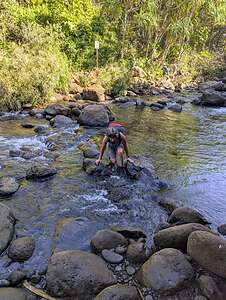 Stream crossing near Hanakapi’ai BeachThe plan a while back was to connect these two road ends allowing for a complete circumnavigation of the island by car, but the ground in between was just too swampy. So the road around Kauai was like a clock with one hour blocked off (the one before midnight), and we had driven every possible bit of it - some of it multiple times.
Stream crossing near Hanakapi’ai BeachThe plan a while back was to connect these two road ends allowing for a complete circumnavigation of the island by car, but the ground in between was just too swampy. So the road around Kauai was like a clock with one hour blocked off (the one before midnight), and we had driven every possible bit of it - some of it multiple times.
When we got to Hāʻena, we realized we would only have time to do the 4-mile, out-and-back hike to Hanakapi’ai Beach. Going all the way to the Hanakapi’aiFalls and back would be about 6 hours in the muddy conditions, bringing us back after dark. Not a very good idea considering how rocky and slippery the trails were with many hazardous stream crossings along the way.
After parking the car, we walked on a boardwalk over taro fields, which were growing in pond water. Taro is a very important Hawaiian crop and a staple in the native Hawaiian diet. It is believed that the plant was brought to Hawaii by ancient Polynesians.
_0.thumbnail.jpg) Finally! Hanakapi’ai BeachThe Kalalau Trailhead was located right near beautiful Ke’e Beach. Rather than stop to enjoy the beach now, we wanted to get the hike done first, because we didn’t know how long it would take.
Finally! Hanakapi’ai BeachThe Kalalau Trailhead was located right near beautiful Ke’e Beach. Rather than stop to enjoy the beach now, we wanted to get the hike done first, because we didn’t know how long it would take.
For some reason I thought a beach (Ke’e) to beach (Hanakapi’ai) hike would be flat, but it was far from it.
The trail, which was very rocky and muddy, immediately began to climb and kept on climbing for the entire first mile.
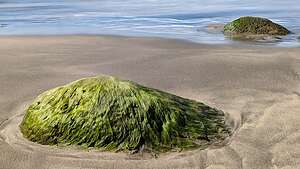 Hanakapi’ai BeachAbout a half mile from the start of the trail, we came to a pretty view below of Ke’e Beach.
Hanakapi’ai BeachAbout a half mile from the start of the trail, we came to a pretty view below of Ke’e Beach.
Then at about a mile into the hike, near the top of the ridge in an opening in the brush, we got our first view of the Napali Coast. As I mentioned earlier, this trail is the only place where you can see the Napali Coast by land.
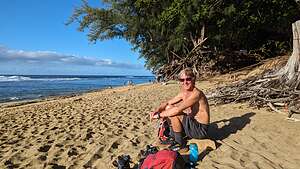 Back to Ke'e BeachFrom there the trail descended down towards Hanakapi’ai Beach just as steeply as it had risen. Downhill is always tougher than uphill, especially when you have to worry about slipping on muddy rocks.
Back to Ke'e BeachFrom there the trail descended down towards Hanakapi’ai Beach just as steeply as it had risen. Downhill is always tougher than uphill, especially when you have to worry about slipping on muddy rocks.
We could see glimpses of the beach as we descended so we knew we were closer. Back down at sea level, we came to a rapidly moving river (stream?) that we had to cross. Rather than try to delicately balance on a series of rocks to get across, I gave up and just got my boots (and my butt) wet. It wasn’t the most dignified crossing, but I didn’t care.
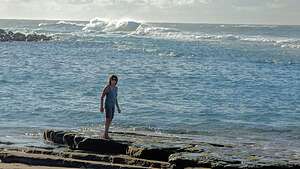 Back on Ke'e BeachIn the winter, Hanakapi’ai Beach is not much of a beach, as the powerful waves and high tides of winter wash away the sandy shore line, leaving just a narrow stretch of sand with lots of boulders, draped by emerald green moss - very pretty. Definitely not a place to lounge and swim at this time of year.
Back on Ke'e BeachIn the winter, Hanakapi’ai Beach is not much of a beach, as the powerful waves and high tides of winter wash away the sandy shore line, leaving just a narrow stretch of sand with lots of boulders, draped by emerald green moss - very pretty. Definitely not a place to lounge and swim at this time of year.
From the beach we headed back from whence we came - across the fast-moving stream, up the muddy, rocky trail to the summit, and slipping and sliding back down again to Ke’e Beach.
Originally I thought we would take some time to relax and maybe even swim on Ke’e Beach, but we were muddy and tired, so after a short time we headed back to the Cliffs at Princeville, where we soaked in the hot tub.
Day 9 - Larsen’s Beach and enjoying the Cliffs at Princeville Pool
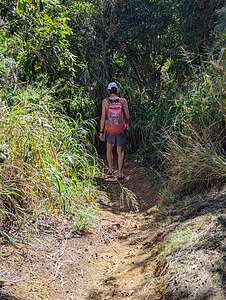 Trail to Larsen's BeachToday the forecast was for rain in the afternoon, so we figured we would get out early while it was still sunny and explore some potential beaches to enjoy tomorrow.
Trail to Larsen's BeachToday the forecast was for rain in the afternoon, so we figured we would get out early while it was still sunny and explore some potential beaches to enjoy tomorrow.
The beach we were particularly interested in seeing was Larsen’s Beach, a secluded and isolated beach on the northeastern shore that just happens to border what the locals call “Zuckerland,” Mark Zuckerberg’s 1,400-acre compound. He calls it Ko'olau Ranch.
His massive construction project includes two mansions (totally over 57,000 square feet), guest houses, a gym and sauna, multiple swimming pools and hot tubs, a tennis court, 11 treehouses with rope bridges and, of course, an underground bunker (in case of societal collapse). And so much more.
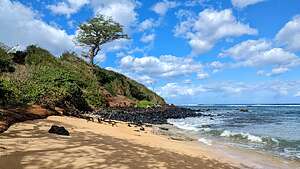 Larsen's BeachIt’s a very controversial and highly secretive project. No one is quite sure exactly what is going on behind the walls.
Larsen's BeachIt’s a very controversial and highly secretive project. No one is quite sure exactly what is going on behind the walls.
The good news is, although Zuckerberg can own all the land above the beach, he can’t own the beach itself.
To get to it we took a dirt road marked “Beach Access,” just west of Moloaa Road. In less than a mile, we came to a small parking lot.
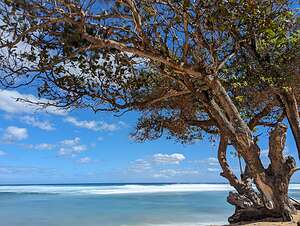 Larsen's BeachFrom there, there were several choices leading to the beach. The one straight ahead was steeper and rougher, so we took the middle one towards the left, which was quite easy and gentle. We weren’t sure if we were actually on Zuckerberg’s property (and he was allowing beach access), or whether we were just skirting it.
Larsen's BeachFrom there, there were several choices leading to the beach. The one straight ahead was steeper and rougher, so we took the middle one towards the left, which was quite easy and gentle. We weren’t sure if we were actually on Zuckerberg’s property (and he was allowing beach access), or whether we were just skirting it.
The beach was lovely - totally void of people, with lovely shade trees to sit under while watching the very large waves breaking over the reef.
We walked along the beach until we came to an impassable outcrop of lava rocks that essentially divided Larsen’s beach in half. I think there is a rough path that goes over the lava rocks to the other sides, but we were perfectly content to stay where we were.
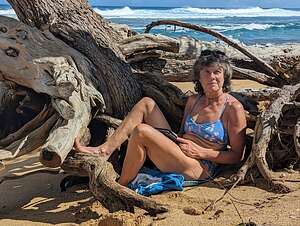 Larsen's BeachThe forecasted rain never came that day, so we spent an enjoyable few house on this lovely beach, me happily reading my book under a shade tree and Herb photographing the giant waves.
Larsen's BeachThe forecasted rain never came that day, so we spent an enjoyable few house on this lovely beach, me happily reading my book under a shade tree and Herb photographing the giant waves.
The winter Hawaiian surf season, which runs from approximately November through March, is where you can expect to see the largest waves, particularly along the north-facing shores where the waves can get up to 30 feet and even 70 feet during the largest swells. I think these waves were about 30 feet high.
.thumbnail.jpg) Giant waves at Larsen's BeachWe watched a young Hawaiian boy tossing a net over and over again into the sea and then retrieving it to see if he had trapped any fish. He was practicing an ancient Hawaiian fishing style.
Giant waves at Larsen's BeachWe watched a young Hawaiian boy tossing a net over and over again into the sea and then retrieving it to see if he had trapped any fish. He was practicing an ancient Hawaiian fishing style.
It involves a lot of patience. Most of the time is spent just quietly staring at the water until you see a school of fish. Then the net is thrown out, forming a circle that drops down to the water, and finally it is pulled in and hopefully emptied of its catch. Unfortunately, the boy caught nothing, at least as long as we were watching.
.thumbnail.jpg) Traditional Hawaiian net fishingLater that day, an older man holding a net stood silently by the lava rocks and then just stared at the water for almost an hour, never throwing his net once as knew there were no fish in reach. Later he wandered along the beach and stopped again. I took my eyes off of him for a while, but when I did look up, I saw him emptying his catch of about 5 small fish from his net onto the beach.
Traditional Hawaiian net fishingLater that day, an older man holding a net stood silently by the lava rocks and then just stared at the water for almost an hour, never throwing his net once as knew there were no fish in reach. Later he wandered along the beach and stopped again. I took my eyes off of him for a while, but when I did look up, I saw him emptying his catch of about 5 small fish from his net onto the beach.
Curious as to what he caught, I strolled down the beach to see. He told me that the fish he caught were “manini” and that they were good to eat.
.thumbnail.jpg) Manini caught in a netI asked if I could take a picture, and he said of the fish, but not him. I’m not sure if Hawaiians were just tired of tourists taking photos of them doing everyday Hawaiian things or whether his catch was legal or not. I later saw that the minimum allowable size to keep a manini is 5 inches and this one might be a little shy of that.
Manini caught in a netI asked if I could take a picture, and he said of the fish, but not him. I’m not sure if Hawaiians were just tired of tourists taking photos of them doing everyday Hawaiian things or whether his catch was legal or not. I later saw that the minimum allowable size to keep a manini is 5 inches and this one might be a little shy of that.
.thumbnail.jpg) Cliffs at Princeville poolWhen I researched this fish a little more, I found out that it is also called the convict tang, I guess because its stripes make it look like it is wearing a cute little prison outfit.
Cliffs at Princeville poolWhen I researched this fish a little more, I found out that it is also called the convict tang, I guess because its stripes make it look like it is wearing a cute little prison outfit.
I was wondering why this fish looked sort of familiar, but then remembered that Herb’s dad had a saltwater fish tank for years with lots of tropical fish, including tangs just like this one.
Still blue skies and no sign of rain, so we managed to get a full beach day out of today. I was so glad, because now rather than making tomorrow (our last day on Kauai) our beach day, we could spend it visiting two places I really wanted to see that were closed today: the Kalalau Lighthouse and the Na ‘Aina Kai Botanical Gardens and Sculpture Park, both of which were closed today but open tomorrow.
Then it was back to the Cliffs and Princeville for some pool and hot tub time! It was a very lovely pool with warm water and even a small waterfall to refresh yourself.
Day 10 - Fitness Center and Pool, Na ‘Aina Kai Botanical Gardens and Sculpture Park, Kilauea Lighthouse and Wildlife Refuge, and Shave Ice
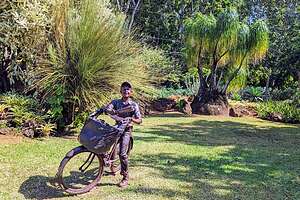 Na ‘Aina Kai GardensBig day for our last day of vacation: a 1:00 tour at the Na ‘Aina Kai Botanical Gardens and Sculpture Park followed by a 3:00 reservation to enter the Kilauea Lighthouse and Wildlife Refuge.
Na ‘Aina Kai GardensBig day for our last day of vacation: a 1:00 tour at the Na ‘Aina Kai Botanical Gardens and Sculpture Park followed by a 3:00 reservation to enter the Kilauea Lighthouse and Wildlife Refuge.
That gave us the entire morning to relax at our resort. We started off with a visit to the fitness center where I did 40 minutes on a stationary bike followed by 20 minutes of lifting. Visiting fitness centers while on vacation is kind of a new thing for us, but we both just finished reading “Outlive: The Science and Art of Longevity,” so we were doing our best to live to be healthy centenarians.
Then it was on to the pool to read and relax for a bit before setting out on our busy day.
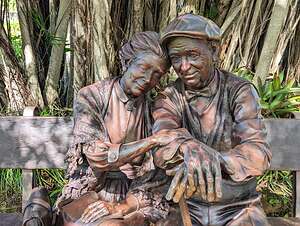 "Valentine"Our first activity of the day was a visit to the Na ‘Aina Kai Botanical Gardens and Sculpture Park, which combines art and nature in a lovely setting. I confess to not knowing much about plants, but I do love art within nature.
"Valentine"Our first activity of the day was a visit to the Na ‘Aina Kai Botanical Gardens and Sculpture Park, which combines art and nature in a lovely setting. I confess to not knowing much about plants, but I do love art within nature.
The gardens were started by Joyce and Ed Doty, a couple that moved to Kauai in 1982 from Santa Rosa, California, our home town. Joyce was actually the ex-wife of Charles Schulz of Peanuts comics fame.
Over the next decades they expanded what was a simple landscape project in the front yard into 240 acres of diverse gardens, complete with one of the largest collections of bronze sculpture in the United States.
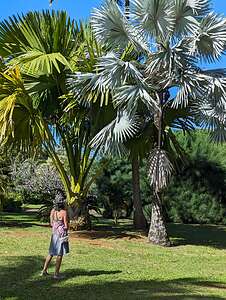 Bismark nobilis palmIn 1999 the Dotys created Na ‘Āina Kai Botanical Gardens, a private foundation, to which they donated the entire gardens. The foundation maintains the gardens and offers a variety of guided tours.
Bismark nobilis palmIn 1999 the Dotys created Na ‘Āina Kai Botanical Gardens, a private foundation, to which they donated the entire gardens. The foundation maintains the gardens and offers a variety of guided tours.
We would have preferred to do a self-guided walk so we could spend time photographing, but they are only offered on Thursdays, which didn’t work for us.
Instead, we signed up for the “The Stroll” tour, where a guide led us through various parts of the garden, explaining the history of the gardens and the plant life along the way.
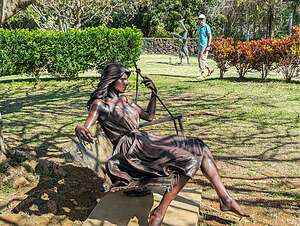 "Hearts on a Swing"Our guide was a naturalist that lived in Alaska during the summer and Kauai in winter. In between, she traveled the world, mostly to tropical places like Tahiti. She was very knowledgeable and interesting.
"Hearts on a Swing"Our guide was a naturalist that lived in Alaska during the summer and Kauai in winter. In between, she traveled the world, mostly to tropical places like Tahiti. She was very knowledgeable and interesting.
She took us through the Formal Gardens and Poinciana Maze, past a Lagoon with a lovely cascading waterfall and tropical island with fountain, a Japanese teahouse, and a Desert and Palm Garden.
My favorite part of exploring the Gardens was being surprised by a bronze sculpture around every turn in the trail.
T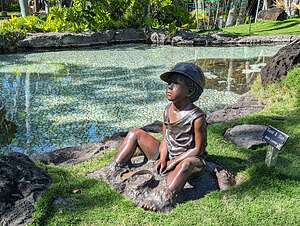 One of the 200 bronze statueshere are 200 life-size, bronze sculptures in the gardens, each done by a Coloradan artist name George Lundeen. I wish I could have seen them all.
One of the 200 bronze statueshere are 200 life-size, bronze sculptures in the gardens, each done by a Coloradan artist name George Lundeen. I wish I could have seen them all.
Joyce never bought a piece until she knew exactly where she wanted to place it in the garden, where it would be integrated into the horticultural setting without competing for attention with other sculptural pieces.
.thumbnail.jpg) Bark of a Rainbow Eucalyptus TreeI found myself losing the tour group because I was admiring and photographing the sculptures rather than learning about the plants.
Bark of a Rainbow Eucalyptus TreeI found myself losing the tour group because I was admiring and photographing the sculptures rather than learning about the plants.
My absolute favorite was a sculpture of an elderly couple sitting on a bench, leaning lovingly towards each other.
The piece, which is very appropriately called “Valentine,” was an anniversary gift from Joyce to Ed. It was their first sculpture in what would become a very extensive collection, many of which from the same artist, George Lundeen of Colorado.
 "Hearts on a Swing"As I mentioned above, Joyce never purchased a sculpture until she knew exactly where she was going to place it in the garden. She chose wisely, placing Valentine beneath the big banyan tree in the Main Garden.
"Hearts on a Swing"As I mentioned above, Joyce never purchased a sculpture until she knew exactly where she was going to place it in the garden. She chose wisely, placing Valentine beneath the big banyan tree in the Main Garden.
I found myself far behind the group, wistfully looking at it, thinking, if we were lucky, that that would be Herb and me someday.
The next sculpture we encountered was of a beautiful young lady sitting casually on a swing, called "Hearts on a Swing." She was lovely.
There were so many more. The subjects reminded me of Norman Rockwell paintings in their quaintness, idealism, and sentimentality.
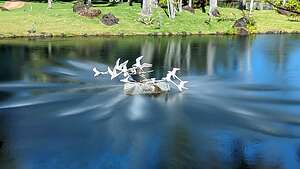 “Flight of the Tropic Birds"The only sculpture we saw that wasn’t by George Lundeen was a beautiful fountain sculpture in the middle of the lagoon called “Flight of the Tropic Birds,” done by artist Panco Vining. Rather than bronze, it was a brilliant white flock of birds.
“Flight of the Tropic Birds"The only sculpture we saw that wasn’t by George Lundeen was a beautiful fountain sculpture in the middle of the lagoon called “Flight of the Tropic Birds,” done by artist Panco Vining. Rather than bronze, it was a brilliant white flock of birds.
Besides the lovely banyan tree under which “Valentine” was placed, we did see many different varieties of palm trees, one of which was the Bismark nobilis palm. A native of Madagascar, this rather unusual palm tree, which grows 30 to 60 feet high has silver green leaves.
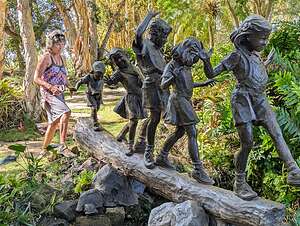 "Follow the Leader"However, my absolutely favorite tree was the rainbow eucalyptus, whose bark was so brightly colored that I couldn’t believe it was natural. But it was!
"Follow the Leader"However, my absolutely favorite tree was the rainbow eucalyptus, whose bark was so brightly colored that I couldn’t believe it was natural. But it was!
This time I did pay attention to our guide as she explained why the bark of this tree looks the way it does. As the tree sheds its bark, it reveals a neon green inner layer. Over time, as this layer is exposed to air, it ages into different colors—bright reds, oranges, blues, pinks and purples. The different colors appear as different layers fall off, while other exposed areas begin aging.
The last sculpture we encountered was another favorite of mine. It was called "Follow the Leader" for obvious reasons. It consisted of five adorable children (and one old lady trying to join them) balancing their way across a log.
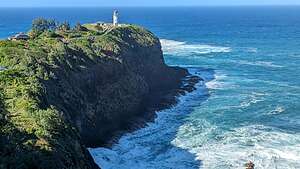 Kilauea LighthouseThe Na ‘Aina Kai Botanical Gardens and Sculpture Park had been a very worthwhile educational and aesthetically- pleasing stop.
Kilauea LighthouseThe Na ‘Aina Kai Botanical Gardens and Sculpture Park had been a very worthwhile educational and aesthetically- pleasing stop.
From the Gardens we continued on to the nearby Kilauea Lighthouse and Wildlife Refuge where we had a 3:00 entry reservation.
The Kilauea Lighthouse stands atop a 180-foot-high bluff above the ocean at the very northernmost point of the Hawaiian Islands.
.thumbnail.jpg) Here come the wavesIn the early 1900s, the U.S. government studied alternatives for placing a lighthouse on Kauaʻi, as it is the first landfall for ships coming from the west. After much study, Kīlauea Point was selected, in part due to its 180-foot elevation, making it less expensive since the tower structure did not have to be taller to be effective. Construction started on July 8, 1912.
Here come the wavesIn the early 1900s, the U.S. government studied alternatives for placing a lighthouse on Kauaʻi, as it is the first landfall for ships coming from the west. After much study, Kīlauea Point was selected, in part due to its 180-foot elevation, making it less expensive since the tower structure did not have to be taller to be effective. Construction started on July 8, 1912.
Already important to marine navigation, the lighthouse also aided aviation since its beam could be seen from 90 miles away from an airplane.
Just after the Japanese attack on Pearl Harbor, the light station went dark until the end of the war.
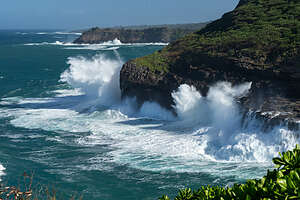 Crashing waves off Kilauea LighthouseIn 1976, the massive beam of Kīlauea Point Lighthouse was replaced by an unmanned automated beacon. Large ships and planes no longer relied on the light for navigation.
Crashing waves off Kilauea LighthouseIn 1976, the massive beam of Kīlauea Point Lighthouse was replaced by an unmanned automated beacon. Large ships and planes no longer relied on the light for navigation.
Today visitors such as us come to view and photograph this beautiful lighthouse.
A wildlife refuge was established on the bluff in 1985 to preserve seabird nesting colonies. It is a wonderful place to see seabirds rarely seen from land, such as the red-footed booby, the great frigate bird, the Laysan albatross, and the endangered nēnē.
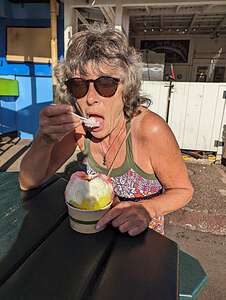 Jojo's Shave IceAlthough we unfortunately did not see much bird activity, we did have a lot of fun watching the giant waves crash on the promontory across the way.
Jojo's Shave IceAlthough we unfortunately did not see much bird activity, we did have a lot of fun watching the giant waves crash on the promontory across the way.
Since it was our last night, and we had run out of Costco food, we decided to drive into Hanalei for a bite to eat. Plus, the last thing we had on our list to accomplish was having a Shave Ice, and there was a Jojo’s Shave Ice in town.
Our original intent was to have a poke bowl at Hanalei Poke, but despite their website saying they were open, they weren’t, so we had a Hanalei Pizza instead. We figured that we should try something Hawaiian, so we had a BBQ pizza with pork, pineapple, and a drizzle of BBQ sauce. Not exactly my favorite, but we thought it needed to be done.
Then it was on to Jojo’s Shave Ice where we managed to gain back all the calories we worked off in our multiple visits to the fitness centers in our hotels. It was decadent. A mound of ice with pina colada and other colada flavored syrup over Macadamia Nut ice cream. It was tasty, but the portion was ridiculously large.
Okay, well we knocked the pineapples on a pizza and shave ice off our list, so I guess it was time to go home.
- ‹ previous
- 2 of 2
North Shore - The Cliffs at Princeville location map in "high definition"
Javascript is required to view this map.
